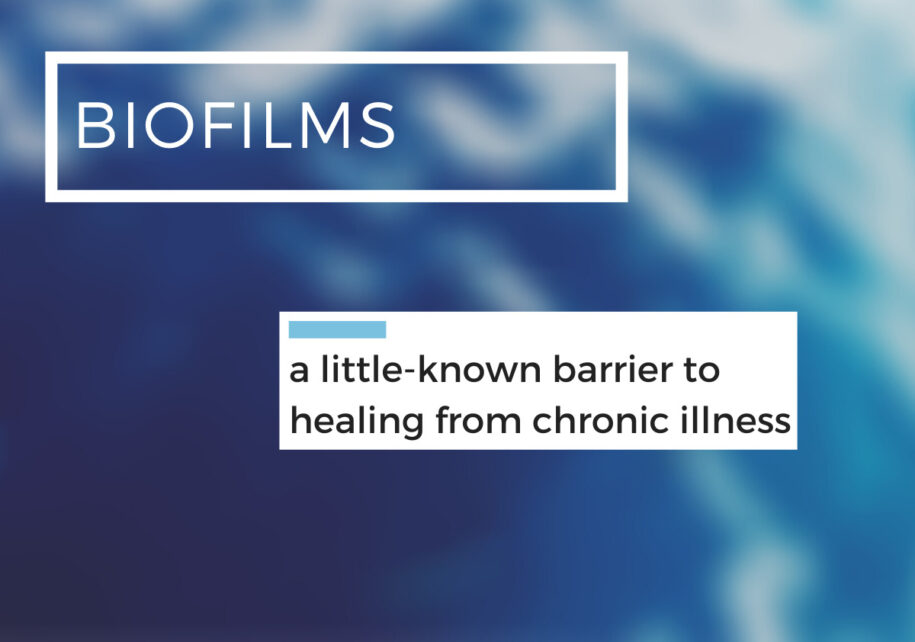| What is biofilm? Biofilms are a type of protective slime that forms around microbial communities like bacteria, fungi, parasites, viruses, and other microorganisms. This film layer or slime layer keeps the colony safe from your body’s natural immune response. Biofilms are a relatively new concept for me but I guess I knew about their existence prior to my new understanding as the film that builds up on our teeth that needs to be dealt with periodically by our dentists. This is just one example of biofilms in and on our bodies. An example of a biofilm in nature is pond scum. A less common example in our bodies would be cystic fibrosis. Biofilms are often associated with chronic diseases.Why does biofilm form? In order to survive, bacteria need to be especially creative and quick to adapt. This is especially true if they want to stay in the rapidly changing environment of your body. For example, when you eat carbohydrates that ferment quickly (sweet treats), the bacteria in dental plaque secrets more acids which goes into the biofilm protecting the bacterial colony. That acid is stuck in the biofilm attached to your tooth enamel. The biofilm then causes demineralization of your tooth enamel. Another example is cystic fibrosis where the patient has chronic bacterial infections. Those bacteria create an antibiotic resistant biofilm throughout the lungs. The persistence of this layer of slime in the lungs causes chronic inflammation by the body’s immune responses. This inflammation, in turn, results in severe damage to the lung tissue. What are the components of biofilms? Biofilms are made of the organisms themselves and also an extracellular polymeric substance (EPS), An EPS is a network of sugars, proteins and nucleic acids (such as DNA). It enables the microorganisms in a biofilm to stick together. (according to the Center for Biofilm Engineering at Montana State University). Attachment is followed by a period of growth. Further layers of microorganisms and EPS build upon the first layers. Ultimately, they create a bulbous and complex 3D structure, according to the Center for Biofilm Engineering. Water channels crisscross biofilms and allow for the exchange of nutrients and waste products, according to the article in Microbe. Is all biofilm bad? Biofilms protect the good bacteria too but are most commonly known for negative effects on the body. |
| How can we break down biofilm to heal? I like to approach biofilms gingerly because I consider it like cracking open “Pandora’s Box”, we don’t truly know what is locked inside of the biofilms or their effects on the system as a whole until we start prodding them. Phase 1 – Aromatic Herbs First, certain herbs, called aromatic herbs, can start to open these biofilms and are also the same types of herbs that might also be able to help treat certain types of infection as well like fungal (yeast), bacterial or archaea infections. Examples of aromatic herbs are:GarlicCinnamonGingerCurcuminOreganoThese are known to target the bad overgrowth while supporting the good microbial communities. Phase 2 – NAC / ALA If the aromatic herbs aren’t quite enough to open and start addressing the organisms stuck in the biofilm, we might progress to using nutrients like N-Acetyl Cysteine and/or Alpha Lipoic Acid. In my experience, I have found that one or the other works better for each patient. It is totally an individual response. Phase 3 If the herbs or other nutrients aren’t enough then we may consider using an Over the Counter (OTC) or prescription Bis-Thiol compounds. Why do we want to address biofilms in the gut? Biofilms can be a reason that our bodies fail to heal from chronic disease. Organisms could continue to have activity in our guts and yet be resistant to being treated or eradicated because of this filmy protective layer that they are embedded in. Cracking open biofilms and addressing the organisms that are hidden within can help our patients heal from long standing illnesses. One other reason that I will do a brief period of treatment with biofilm disruptors is when we are preparing to do a 3 day stool test. This can help us get the most out of these (often expensive) tests by helping to release potential pathogens hidden in biofilms so that they can be detected by the lab. I have absolutely found an increase in tests that are positive (with pathogens being identified so we can treat them) since I started using biofilm disruptors in this way. If you have had ongoing, chronic gut issues that are not clearing with standard treatments, you may want to do a 3 day stool test or deeper level intervention with me and we may discover that biofilms are part of the barrier to your healing. |
| Fun Fact About Biofilm Research: For medical implants and catheters, surfaces are being re-engineered so that they are less prone to develop biofilm. Shark skin inspired this change! Researchers noticed that sharks don’t have anything that attaches or grows on their skin. |
